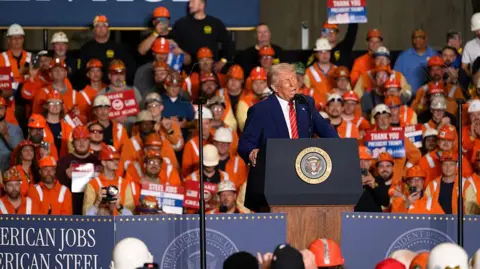In a significant economic move, President Donald Trump announced that the United States will be increasing its tariffs on steel and aluminum imports, raising the rate from 25% to an unprecedented 50%. This announcement was made during a rally held in Pittsburgh, Pennsylvania, a location synonymous with America’s steel industry. According to Trump, the decision is intended to bolster the local steel sector, enhance the national supply, and lessen dependency on imports, particularly from China.
At the rally, Trump mentioned that an anticipated investment of $14 billion would come through a partnership between U.S. Steel and Japan’s Nippon Steel. Despite this optimistic projection, Trump later indicated to reporters that he had not yet seen or approved the final details of this partnership, emphasizing a level of caution amidst his assertive promises. The rally, characterized by a supportive crowd made up predominantly of local steelworkers, echoed Trump’s previous rhetoric surrounding tariffs, marking yet another development in his sweeping trade policy since resuming office in January.
Trump reassured the audience that the tariff increase would prevent layoffs and outsourcing, claiming that every steelworker in the U.S. would receive a $5,000 bonus. This statement was met with enthusiasm, as the audience, in full support, cheered at the prospect of job security and financial rewards. One of the concerns raised by the steelworkers pertains to how Japan will handle the terms of the workers’ union contracts, which are crucial for regulating pay and hiring practices in the industry.
This renewed approach to tariffs follows Trump’s previous assertion that he “saved” U.S. Steel during his first term by imposing the initial 25% tariffs in 2018. He touted this jump to 50% as a pivotal strategy to ensure the survival of the American steel industry. Trump passionately declared, “At 50%, they can no longer get over the fence,” indicating that the U.S. would reinvigorate its manufacturing backbone, particularly in Pennsylvania.
However, the steel industry has seen a decline in recent years with countries like China, India, and Japan emerging as leading producers. Currently, around a quarter of all steel consumed in the U.S. is imported, a situation Trump has criticized, particularly regarding the country’s dependence on steel from Mexico and Canada. The announcement of the increased tariffs arrives during an ongoing legal dispute regarding the legality of some of Trump’s international tariffs, which an appeals court has permitted to continue.
While Trump’s recent tariffs on steel and aluminum have not been directly impeded by the legal challenges, they reflect a broader pattern of trade tensions that have been exacerbated by his administration’s aggressive approach. This has led to strained relations with China and sparked a tit-for-tat trade war between the two nations, both of whom are key players in the global economy.
During the rally, Trump mentioned China’s role in global steel production, highlighting that the country produces over half of the world’s steel. He humorously contended, “If you don’t have steel, you don’t have a country,” associating national security with domestic steel production capabilities. It underscores his administration’s mantra that economic self-sufficiency is crucial for maintaining a strong military and government.
Although some local leaders, like JoJo Burgess from the United Steelworkers union, expressed cautious optimism about the new partnership with Nippon Steel, they also acknowledged the broader economic chaos that has followed Trump’s tariffs. Burgess, who serves as the mayor of Washington, Pennsylvania, expressed that although he does not identify as a supporter of Trump, he could not argue against initiatives that promote fair competition for American manufacturers.
Despite these positive sentiments, the reality remains that the global trade landscape continues to become increasingly fractured, with the fallout from tariffs impacting markets and international relations. As the complexities of trade deals unfold, the implications of Trump’s ambitious tariff strategy remain to be seen, and the future of steel manufacturing in the U.S. faces uncertainty amidst broader global economic ramifications.



